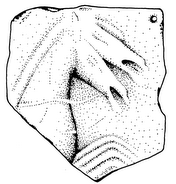Under the auspices of the Canadian Institute in Greece (CIG) and with the kind permission granted to us by the 11th Ephorate of Prehistoric and Classical Antiquities at Chalkis (IA EPKA) the Southern Euboea Exploration Project (SEEP) was able to continue work in the area of Karystos in July and August of 2006. Unlike previous seasons, the primary focus in 2006 was on the fieldwork consisting of a new project of survey in the alluvial plain (Kampos) west of the town of Karystos. In addition to new fieldwork, members of SEEP were also engaged in the study of the previously collected material housed in the Karystos Museum. The work was made possible and greatly facilitated by the help from Ms. Maria Kosma, the epimeletria for the region as well as Mrs. Sofia Stambelou and Mrs. Evangelia Athanasiou, the museum guards at Karystos.
Work in the field
In July and August of 2006 members of SEEP began the survey of the Kampos plain west of Karystos. Mrs. Maria Chidiroglou and Mr. Zarko Tankosic of Indiana University served as the co-field directors of the project. Members of the surveying teams were: Dr. Donald Keller, Ms. Wendy Porter, Ms. Melody Childs, Mr. Jeremy Ott, and Mr. Petros Tryfonopoulos.
The fieldwork was conducted in the course of three weeks in July and August of 2006. Although the original plan was to complete a four week field season, we were forced to shorten it because of other pressing obligations.
The goals of the survey were to: examine a hitherto archaeologically poorly known part of the Karystia; methodologically and spatially connect the two previously surveyed areas in the region where different survey methods were employed (e.g. Bouros-Kastri to the east and Paximadhi to the south of the Kampos); test the hypothesis that in an alluvial plane like the Kampos the probability of finding sites increases in the vicinity of modern roads and paths, gullies, and the foothills of the surrounding hills; test the hypothesis that some of the modern roads or trails were also used in ancient times.
The survey methodology consisted of following transects that were predetermined either by natural features of the investigated landscape or by man-made alterations thereof. These transects were supplemented by the artificial ones that were created based on our knowledge of the area, its cultural resources, and our expectations (based on experiences from the previous surveys in the Karystia) about where the most likely locations of the findspots would be. In this way our transects consisted of gullies, streambeds, and other water flows; modern and pre-modern routes including asphalt and dirt roads, kalderimis, trails, and footpaths; and one long transect encompassing the limits of the survey area and following the natural boundary of the Kampos plain on the foothills of the surrounding hills north and south of the plain proper. The transects were c. 10 m to 30 m wide, with investigators spaced 10 m from each other assuming that they can visually cover the area of 5 m on both sides of them. Furthermore, some discrete features of the landscape adjacent to the transects were surveyed in their entirety if they looked promising as potential findspot locations.
Since the rationale behind this approach was that the potential findspots will be on or in the vicinity of the proposed transects, surveyors were allowed the freedom to step away from the transect lines per se and investigate the surrounding natural and manmade features that looked like they might be locations of possible findspots. Furthermore, if a findspot was located on or in the immediate vicinity of one of the transects then the adjacent area was also investigated in more details in order to locate the findspot’s boundaries and other features associated with it. This approach proved fruitful as a number of findspots were found outside of the transects proper at a distance of 30–50 m to either side of them.
A total of twenty findspots were discovered during the first field season with about 70–80% of the planned transects investigated. The catalogue of findspots attached to this report lists their name, location (in the form of degree-minute-second map coordinates), preliminary dating of the material, and the type of the findspot. The names of the findspots are in the form of a unique code consisting of the year of the survey (06), location in relation to the main modern road (North or South of it), and a unique two-digit continuous number of the findspot (e.g. 01).
The survey area is spread over the following 1:5000 topographic maps: 6541/5, 6541/6, 6541/7, 6541/8.
Preliminary results
The preliminary results of the survey suggest that at least the route of the main modern road connecting Karystos to Marmari (which, more or less, follows the route of the older road that dates to at least the 19th century) could have been used as a thoroughfare in ancient times since there are a number of findspots located along its course, supplemented by a number of stray finds (e.g. random pottery sherds, sandstone Roman building blocks, etc.). Also, our finds indicate that most of the alluviation in the Kampos plain happened sometime before the Roman period, regardless of whether it was in the form of a single event or a long-term continuous process. This is tentatively indicated by the fact that pre-Roman finds in the area are not present at the floor of the plain but either on the adjacent foothills or rocky outcrops protruding into the plain from the surrounding hills.
Naturally, these observations are highly preliminary and a lot more study is needed until more definite conclusions can be drawn.
Submitted to CIG and IA EPKA 2006

No comments:
Post a Comment